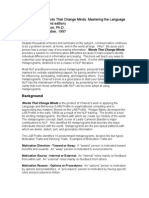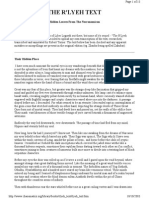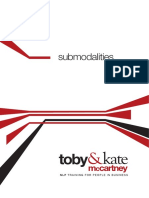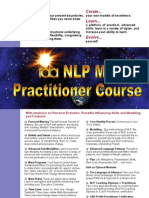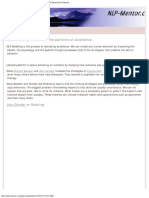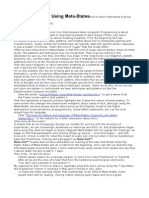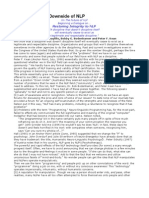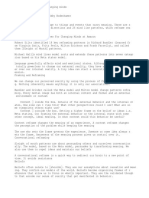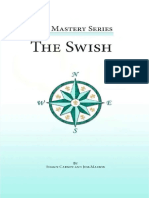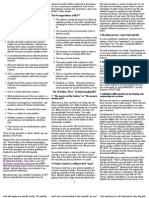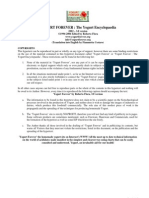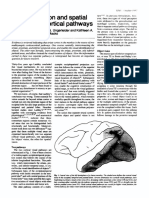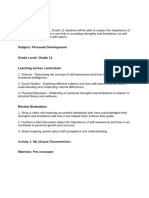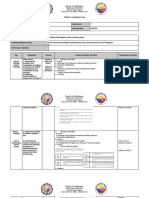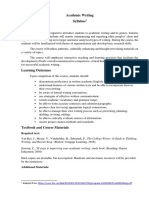Using NLP On Yourself
Using NLP On Yourself
Uploaded by
mitovedi4608Copyright:
Available Formats
Using NLP On Yourself
Using NLP On Yourself
Uploaded by
mitovedi4608Original Title
Copyright
Available Formats
Share this document
Did you find this document useful?
Is this content inappropriate?
Copyright:
Available Formats
Using NLP On Yourself
Using NLP On Yourself
Uploaded by
mitovedi4608Copyright:
Available Formats
Rewire Unhelpful Emotional States:
[For
the
purpose
of
this
assignment
and
in
keeping
with
working
on
your
self,
this
technique
is
helpful
for
everyday
life
unhelpful
emotional
responses
that
vary
on
the
level
from
0-6.
This
approach
is
not
recommended
for
highly
traumatic
incidents.]
This
next
assignment
is
one
of
the
most
useful
NLP
processes
you
can
drive
yourself
through
in
order
to
have
more
freedom
and
choice
in
any
given
moment.
All
of
us
at
some
time
or
other
have
been
pre-wired
up
to
have
certain
unhelpful
emotional
states
when
specific
things
happen
in
our
life.
In
fact
this
process
is
an
example
of
unconscious
learning
and
is
occurring
all
the
time.
For
example
two
months
ago
you
loved
getting
take-away
from
that
special
Indian
curry
house
but
now
the
thought
of
eating
there
makes
you
feel
yuck-ee!.
A
something
happened
between
the
first
time
you
eat
from
there
vs.
how
you
feel
about
it
now.
This
change
didnt
just
descend
upon
you
one
day
for
without
any
cause.
Throughout
our
life
we
are
all
getting
wired
up
to
have
a
certain
emotional
responses
to
various
experiences.
This
is
an
invaluable
and
essential
skill
for
our
survival,
and
is
very
diverse.
In
fact
the
same
external
stimulus
can
result
in
two
very
different
emotional
responses.
For
example
take
something
like
the
Tower
of
Fear,
a
common
adventure
ride
at
amusement
parks.
The
Tower
of
Fear
is
a
225-foot
high
vertical
tower
which
adventure
park
customers
get
on
to
get
their
adrenaline
going.
Imagine
this:
you
sit
into
this
hard
plastic
chair,
this
locking
arm
is
pulled
down
over
your
head
to
keep
you
secure,
but
you
dont
feel
snug.
There
is
an
uncomfortable
amount
of
room,
which
feels
like
it
could
but
big
enough
for
you
to
slide
out
(of
course
though
it
isnt).
There
are
three
to
four
chairs
per
row
and
once
everyone
is
onboard,
the
chairs
slowly
wind
up
to
the
top
of
the
tower.
You
quickly
become
aware
of
your
feet,
which
are
hanging
loose
and
unrestrained
beneath
you.
You
can
see
the
amusement
park
growing
smaller
and
smaller
below
you
and
right
there
in
front
of
you
is
this
every
expanding
vista
of
the
park
below
and
the
city
beyond
the
edge
of
the
park
area.
As
the
chair
continues
to
rise,
you
begin
to
realize
how
high
up
you
really
are!
Then
suddenly
the
chair
come
to
a
halt,
you
wait
nervously,
and
then
without
warning
free-fall
drop
about
200
feet
rapidly
heart
beating
out
of
your
chest
before
slowing
to
a
halt
at
the
bottom,
and
a
great
sense
of
relief
rushes
through
your
body.
The
experience
was
somewhat
petrifying.
You
turn
to
your
right
and
you
see
a
young
twelve-year-old
boy
who
is
smiling
broadly
saying:
Can
I
go
again,
mommy?
PLEASE!!.
Copyright NLPTIMES.COM, all rights reserved in all media.
He
looks
totally
delighted.
You
walk
away
wondering,
how
is
he
able
to
not
be
scared?
You
see
the
fascinating
thing
is
even
when
two
people
have
the
near
same
physical
experience
their
brains
can
wire
up
two
very
different
messages
about
what
that
same
stimulus
means.
The
good
news
is
whatever
your
current
undesired
emotional
response
is,
it
doesnt
need
to
be
that
way.
You
can
choose
and
then
re-wire
yourself
to
response
differently
to
just
about
any
situation.
There
are
many
contexts
in
which
having
greater
choice
about
how
we
will
respond
can
be
useful.
In
the
video
I
shared
with
you
an
example
of
a
business
situation
where
a
hypothetical
colleague
called
Mary
had
a
perceived
derogatory
tone
that
caused
an
unwelcome
response.
From
an
NLP
perspective
we
call
this
an
example
of
a
powerful
anchor
that
fired
off
a
series
of
representations
that
lead
to
an
unwanted
feeling
annoyance!
Most
unhelpful
emotional
states
will
have
a
similar
structure.
Our
thoughts
and
feelings,
for
the
most
part
dont
just
come
out
of
the
air
and
suddenly
infect
us
with
bad
feelings.
If
we
werent
born
into
the
world
feeling
an
instant
sense
of
annoyance
towards
all
people
who
are
called
Mary
or
who
whenever
talk
in
a
specific
voice
tone
create
a
feeling
of
annoyance
then
somewhere
along
the
way
you
had
one
ore
more
experiences
where
you
unconsciously
LINKED
UP
(created
an
anchor)
that
whenever
X
happens
Y
occurs.
So
first
off
list
out
ten
areas
of
your
life
where
apparently
someone
or
something
causes
you
to
feel
or
experience
an
undesirable
emotional
state.
Detail
what
the
trigger
is
and
the
desired
emotional
state
instead.
Ive
includes
a
sample
in
the
table
below.
You
are
going
to
use
the
second
half
of
this
assignment
to
re-wire
these.
Undesired Emotional States:
Undesirable
Emotional
State
Trigger(s)
Desired State
E.g. Annoyance
Whenever I see my partners
clothes left on the floor
Calmness
E.g. Helplessness
My mother looking at me, he
head is tilted to the right and
she is squinting at me, while
her lips are downturned
Laughter
Copyright NLPTIMES.COM, all rights reserved in all media.
Undesirable
Emotional
State
Trigger(s)
(Describe
using
sensory
based
words)
Desired
State
(Describe
using
sensory
based
words)
Copyright NLPTIMES.COM, all rights reserved in all media.
Re-wiring your own emotional states:
There are several keys to re-wiring an unhelpful emotional state.
These are:
1. Have a clear representation of what it is you want instead of your
current behaviour. What is the desired state you wish to experience in
the place of the current emotion?
Make sure you are able to describe that desired state/behaviour in
sensory-based words. Rather than saying I want to feel happy,
you might say I want to be standing up right, breathing fully from
my chest, there is a big smile on my face and I see
The reason why you want sensory based description of what you
will be occurring when you are doing the state of happiness is so
your brain and body knows this is what the target is.
2. Know what is the trigger that your brain is currently wired up to,
so that it gets when X happens -> Y will occur.
The trigger will be a representation (a sight, sound, smell, taste,
touch) either internal (meaning for example a picture you see in
your mind, a sound you hear, a smell etc.) or external (a sound that
you hear in the physical world, a certain look a person gives you
etc.) that triggers your brain to fire off an unwanted emotional
response.
In the previous video example the trigger that fired off the feeling
of annoyance was the tone of voice and the specific look (looking
down her nose) that Mary provided.
3. Modifying the trigger so that it swishes your brain in a new
direction toward the desired response.
Modifying the trigger can refer to 1) interrupting the triggering
process so that the emotional response never fires and therefore
the strategy never runs, 2) re-engineering the strategy so that
when the trigger fires the brain has been conditioned to go down
a new/different path than the previous and therefore the emotional
response doesnt occur or 3) breaking up the old trigger so that
when it now fires the brain does not go down the old path but does
something else.
Copyright NLPTIMES.COM, all rights reserved in all media.
4. Conditioning
the
new
pattern
until
it
has
stuck.
Training
your
brain
so
that
it
acts
the
way
you
want
is
key.
We
have
many
ways
to
train
the
brain
to
learn
a
new
pattern
of
behaviour.
Two
of
the
most
simple
and
effective
are
the
NLP
Swish
technique
and
process
of
driving
yourself
through
the
new
strategy
over
and
over
5-15
times
until
the
brain
gets
Oh
right
this
is
how
he/she
wants
me
to
respond/act
in
this
situation
Notice
I
use
the
phrase
driving
yourself
through
the
new
pattern.
This
phraseology
is
intentional.
The
big
mistake
that
Ive
seen
many
NLPers
make
is
they
simply
try
on
a
pattern
but
have
no
intensity
to
it,
therefore
the
brain
is
left
going
no-thing
of
interest
going
on
here
and
does
not
learn
the
pattern.
If
you
want
to
have
the
pattern
stick
then
it
is
essential
that
you
immerse
yourself
whole-heartedly
into
doing
the
pattern.
The
richer,
more
vivid
and
real
you
can
make
the
whole
conditioning
experience
the
faster
the
brain
will
learn
and
the
more
the
change
will
stick.
Vividness
and
intensity
play
a
key
role
in
conditioning
in
new
behaviour.
Hence,
if
we
go
back
to
the
two
customers
on
the
Tower
of
Fear
ride,
both
will
have
strong
feelings
evoked
in
them
by
the
experience
because
it
was
intense.
They
designers
of
the
amusement
ride
were
very
intentional
in
trying
to
make
it
as
dramatic
and
intense
as
they
could
so
that
it
would
evoke
a
state
of
terror
or
exhilaration
dependant
on
the
worldview
of
the
customer.
At
this
point
in
the
assignment
you
should
have
a
list
of
ten
undesirable
emotions,
ten
triggers
and
ten
desired
states.
Implementing the process:
Take the first undesirable state on your list and go through the process outlined
below to wire up a new emotional response. Remember as Michael outlined in
the original video in this program, you develop the resourcefulness in yourself
before you need it.
1. Think of the person or situation that fires off in you an unwanted
emotional response.
2. While holding that state, identify the trigger(s) what is/are the
things/representations that fires off the unwanted emotional state in
you? If you have done part 1 of this assignment then you will know what
it is. (There may be more than one trigger for you, list them all).
Copyright NLPTIMES.COM, all rights reserved in all media.
3. Now
is
the
time
for
you
to
mess
with
that
trigger(s1)
You
can
a. Change
any
sub-modality
aspects
of
it.
The
sub-modality
aspect
of
our
sensory
system
refers
to
the
qualitative
aspect
of
our
experience.
For
example
for
the
visual
sensory
system
we
have
how
close/far
a
picture
away
is,
is
the
representation
a
movie
or
a
still?,
how
many
images
are
there
present?,
how
clear
or
hazy
is
the
image(s)?,
how
big
or
small
is
the
image(s)?,
are
you
seeing
the
yourself
in
the
picture
(disassociated),
or
are
you
looking
at
events
unfold
through
your
own
eyes
(associated)?,
etc.
etc.
So
similar
to
my
video
about
Mary,
my
trigger
was
a
condescending
voice
tone
and
her
looking
down
her
nose.
This
evoked
a
state
of
annoyance
in
me
So
I
changed
the
voice
tone
to
being
ridiculous
and
the
look
on
Mary
to
one
of
having
Mickey
Mouse
ears
on
and
a
big
Pinokio
nose.
I
heard
my
inner
voice
say
in
playful,
piss-taking
way
say
Ahh,
Mary
she
is
a
soft
touch.
1
If
you
have
more
than
one
trigger
which
can
fire
off
the
unwanted
state
in
you,
then
you
will
want
to
mess
with
each
trigger
systematically
and
change
the
sub-modality
aspect
significantly
for
each.
Copyright NLPTIMES.COM, all rights reserved in all media.
I quickly rehearsed seeing/hearing things this new way 2-3 times
and instantly these changes made the representation of her
ridiculous and caused me to laugh I was at the point where I
couldnt take Marys condescending look seriously.
Now
you
do
the
same.
Generate
3-5
big
changes
in
the
old
way
you
represented
the
triggering
thought(s)
and
replace
it
with
the
new
thought
process,
which
has
all
the
key
changes.
If
the
old
emotion
feels
heavy
then
break
state
change
your
physiology,
fire
off
one
or
more
of
your
accessing
state
anchors
and
become
playful/creative
as
you
think
up
of
3-5
different
ways
to
re-present
that
old
stimulus
to
your
mind.
Make
sure
you
go
for
exaggerated
changes
that
cause
your
mind
to
go
over
threshold
and
cant
but
change
the
way
you
feel
about
it.
Run
the
movie
through
three
times
looking
to
find
additional
ways
to
change
it
so
you
cant
take
it
seriously!
You
know
you
have
been
effective
when
you
cant
hold
the
same
emotional
state
that
you
once
did,
that
it
causes
you
to
significantly
change
state.
Great
states
to
aim
to
evoke
from
yourself
include
laughter,
ridiculousness,
silliness
or
feelings
of
whats
all
the
fuss
been
about
it
feels
unimportant.
When
you
have
changed
your
state-response
adequately
by
changing
the
sub-modality
aspects
of
the
representation
you
will
then
want
to
Copyright NLPTIMES.COM, all rights reserved in all media.
b. Anchor
the
new
positive
response
As
soon
as
you
evoke
a
powerful
positive
state
anchor
it!
The
new
emotional
response
will
be
a
resource
you
can
use
to
solidify
the
change
and
quickly
swish
your
brain
to
how
you
want
to
respond
in
the
future
when
you
face
the
pervious
stimulus.
The
key
to
anchoring
yourself
is
to
first
be
fully
in
the
feeling
of
the
positive
state
(that
is
associated)
and
then
do
anything
unique
and
consistent
to
mark
out
the
event
in
multiple
sensory
systems.
In
the
video
demo,
I
showed
you
how
I
anchored
myself
to
three
things:
the
fully
bodied
sound
of
me
clicking
my
fingers
followed
by
the
word
BOOM(auditory
anchor)
and
the
outward
chopping
expression
with
my
hand
(both
visual
and
kinesthetic
anchor).
Copyright NLPTIMES.COM, all rights reserved in all media.
Which trigged a radical state change in me
From annoyance
To joy and laughter.
So as soon as you have a full-bodied powerful positive state evoked,
make sure you do something unique and consistent to anchor it.
Copyright NLPTIMES.COM, all rights reserved in all media.
Next
time
you
run
the
pattern
through
use
the
anchor
to
fire
off
the
positive
feeling
and
intensify
the
state
you
are
already
experiencing.
This
will
give
your
brain
the
instructions
wire
this
thought-feeling-
response
up.
You
want
to
get
yourself
to
the
point
where
replaying
the
movie
of
the
old
context
instantly
your
mind-body
flies
down
the
new
path
of
seeing
the
situation
unfold
BUT
with
the
new
changes
in
the
way
you
now
represent
it
(the
sub-modality
shifts)
included
and
you
have
a
positive
state
response
which
you
anchored.
Then
the
second
time
through
the
process
you
fire
off
your
auditory/kinesthetic/visual
anchor
to
intensify
your
new
positive
feelings.
4. Then
generate
a
phrase
that
is
congruent
with
the
outcome
you
want
and
continues
the
direction
your
brain/state
is
headed
The
second
last
step
to
re-wiring
up
a
new
emotional
response
is
to
generate
a
phrase
that
is
congruent
with
the
outcome
that
you
want
and
pushes
your
brain
to
continue
in
the
direction
you
have
set
it.
So
for
me
the
phrase
I
used
was
Ahh
Mary
she
is
a
soft
touch
shes
alright
said
in
playful
voice
tone.
This
moved
me
from
laughter,
in
to
a
state
of
relaxation,
then
a
feeling
of
being
at
ease
and
completes
the
desired
state
response.
The
completed
emotional
state
chain
sequence
looks
as
follows:
Annoyance
>>
Laughter
>>
Silliness
>>
Relaxation
>>
Ease
(not
bothered)
Generate
2-3
different
phrases
that
reinforces
the
direction
you
want
your
brain
to
try
them
out
as
you
run
through
the
new
state
response
process.
Choose
to
pick
a
phrase
and
tone
that
amplifies
the
positive
state
you
are
in
and
accentuates
that
direction
into
the
end
desired
state
you
want
to
feel.
5.
Lastly
Condition
the
Change
&
Test.
The
final
step
in
the
re-wiring
emotional
states
process
is
to
condition
in
the
change.
This
means
repeat,
repeat
and
repeat
again
the
new
process
you
have
wired
up,
each
time
looking
to
enrich
and
intensify
the
new
positive
state
direction
you
have
trained
your
brain
to
do
whenever
the
old
trigger
shows
up.
Copyright NLPTIMES.COM, all rights reserved in all media.
How
many
times
you
will
need
to
repeat
the
process
will
vary
from
person
to
person.
The
key
is
to
cycle
fast
through
it,
each
time
running
through
the
new
strategy
over
and
over
and
giving
your
brain
the
necessary
information
for
it
to
go
OK
this
is
how
I
am
to
act
when
I
see/hear/feel
this.
Future
pace
the
change
by
seeing
yourself
in
the
upcoming
context
when
you
will
next
likely
have
X
event
occur
and
notice
yourself
responding
the
way
you
want.
Then
imagine
the
situation
is
occurring
right
now
and
see/hear/feel
the
trigger
response
occurring
and
instantly
the
desired
response
should
occur
as
you
saw
with
me
in
the
video.
In
fact
when
you
have
done
this
really
well,
you
will
find
it
difficult
to
recall/re-enact
the
old
trigger
and
response,
because
your
brain
has
been
trained
to
hear/act/experience
the
trigger
and
everything
that
comes
after
it,
based
on
the
new
wired
up
response.
Once
you
have
conditioned
in
the
change
you
need
to
test
the
entire
response.
The
best
test
is
to
put
yourself
in
the
context,
which
previously
you
were
triggered
negatively
and
notice
how
you
respond.
If
the
state
chaining
has
been
conditioned
in
thoroughly,
then
you
will
enjoy
the
new
response,
each
and
every
time.
And
once
that
happens
you
can
forget
about
it
and
let
your
unconscious
mind
take
full
responsibility
for
this
new
change
to
stay
with
you
and
you
can
go
on
living
your
life,
enjoying
greater
choice,
resourcefulness
and
freedom.
Once
you
have
run
through
this
process
successfully
for
your
number
1
undesired
emotional
response,
move
on
to
the
next
one
from
your
list
until
you
have
done
all
ten.
As
you
do
so
you
will
have
taken
a
huge
leap
forward
in
creating
more
of
the
life
you
want
Copyright NLPTIMES.COM, all rights reserved in all media.
You might also like
- NLP Master Practitioner's Complete Guide to Breakthrough SessionsFrom EverandNLP Master Practitioner's Complete Guide to Breakthrough SessionsRating: 5 out of 5 stars5/5 (5)
- Auspicium NLP Practitioner QuestionsDocument25 pagesAuspicium NLP Practitioner QuestionsPhong NguyễnNo ratings yet
- Words That Change MindsDocument4 pagesWords That Change MindsCarolinaSevillaNo ratings yet
- ANLP 30-Day Action Plan Ver 1.0 PDFDocument32 pagesANLP 30-Day Action Plan Ver 1.0 PDFThành Trung Nguyễn100% (5)
- (Ebook - NLP) - Robert Dilts - Articles and PatternsDocument396 pages(Ebook - NLP) - Robert Dilts - Articles and Patternspeacemantra123100% (6)
- Submodalities Belief Change Script: The Accelerated NLP Practitioner TrainingDocument1 pageSubmodalities Belief Change Script: The Accelerated NLP Practitioner TrainingRobert Holzhauser100% (1)
- The R'lyeh Text - NecronomiconDocument13 pagesThe R'lyeh Text - Necronomiconmitovedi4608No ratings yet
- Shapes of NailDocument8 pagesShapes of NailJesalie Dacuan LeidoNo ratings yet
- Notes 8 SubmodalitiesDocument17 pagesNotes 8 Submodalitiesигнат дълбоковNo ratings yet
- The Forgiveness Pattern HandoutDocument7 pagesThe Forgiveness Pattern HandoutAdelaide NuñezNo ratings yet
- NLP Master Practitioner Course PDFDocument4 pagesNLP Master Practitioner Course PDFfdaniels99933% (3)
- Stortytelling Golden Keys Training TranscriptDocument215 pagesStortytelling Golden Keys Training TranscriptBiljana Kusljevic100% (4)
- Levels of Awareness and BeingDocument6 pagesLevels of Awareness and Beingseo_girl100% (4)
- All SleightOfMouthDocument2 pagesAll SleightOfMouthrholzhauser01100% (1)
- NLPDocument9 pagesNLPG.R.S50% (2)
- Helping Children Regulate Emotions by Carolyn Webster-StrattonDocument8 pagesHelping Children Regulate Emotions by Carolyn Webster-Strattonmitovedi4608No ratings yet
- Using Love and Logic To Help Children Develop Attention and Behavior SkillsDocument221 pagesUsing Love and Logic To Help Children Develop Attention and Behavior Skillsmitovedi4608No ratings yet
- NLP Café: Get Cookin' at TheDocument33 pagesNLP Café: Get Cookin' at TheSabine ChartouniNo ratings yet
- Purest Persuasion - Assignment 5Document2 pagesPurest Persuasion - Assignment 5angel 1958No ratings yet
- NLP - Meta Masters - NS-NLP Master Practitioner Course Outframed With Meta-States - Michael HallDocument197 pagesNLP - Meta Masters - NS-NLP Master Practitioner Course Outframed With Meta-States - Michael HallflorianNo ratings yet
- 2012 Meta NLP Full TextDocument154 pages2012 Meta NLP Full Textflorian100% (1)
- Rex Sikes Ultimate NLP Home Study CourseDocument169 pagesRex Sikes Ultimate NLP Home Study Coursenamron100% (4)
- Meta-Nlp: Accelerated NLP Practitioner TrainingDocument51 pagesMeta-Nlp: Accelerated NLP Practitioner TrainingMichiel Paulus100% (1)
- NLP Course OutlineDocument2 pagesNLP Course OutlineVisesh0% (1)
- NLP Modeling, Finding The Structure of ExcellenceDocument6 pagesNLP Modeling, Finding The Structure of ExcellenceSan HeNo ratings yet
- NLP - MindLines (Sleight of Mouth)Document10 pagesNLP - MindLines (Sleight of Mouth)Marco Baratta100% (1)
- Michael BreenDocument4 pagesMichael Breenlancelot85100% (1)
- Accelerating NLP Using Meta StatesDocument2 pagesAccelerating NLP Using Meta StatesamarshNo ratings yet
- Rapport: Are You Limiting Yourself With The Law of Attraction?Document16 pagesRapport: Are You Limiting Yourself With The Law of Attraction?Adil 7100% (1)
- NLP - L. Michael Hall Dealing With The Downside of NLPDocument4 pagesNLP - L. Michael Hall Dealing With The Downside of NLPMarco Baratta100% (1)
- Wp-Content Uploads 2014 2014-Catalog-1 PDFDocument74 pagesWp-Content Uploads 2014 2014-Catalog-1 PDFzeya200120010% (1)
- NLP & DHE - Replacing Smoking With NLP (Neuro-Linguistic Programming)Document3 pagesNLP & DHE - Replacing Smoking With NLP (Neuro-Linguistic Programming)Cathy Apan100% (1)
- Transderivational Search: TDS in Human Communication and ProcessingDocument3 pagesTransderivational Search: TDS in Human Communication and ProcessingZorica TrailovicNo ratings yet
- PDF Guide To Choosing An NLP Practitioner Course 31 132Document15 pagesPDF Guide To Choosing An NLP Practitioner Course 31 132Krishnamurthy NarayananNo ratings yet
- FramingDocument4 pagesFramingssh100% (1)
- NLP Patterns For SuccessDocument14 pagesNLP Patterns For SuccesscibrdtrendsNo ratings yet
- NLP Module 3 Representational SystemsDocument43 pagesNLP Module 3 Representational SystemsJhunar John TauyNo ratings yet
- Elman Banyan Script PDFDocument2 pagesElman Banyan Script PDFvova100% (2)
- Meta-NLP Curriculum PDFDocument4 pagesMeta-NLP Curriculum PDFGalal NadimNo ratings yet
- TheMetaModel PDFDocument15 pagesTheMetaModel PDFRadomir Nikolic100% (2)
- Magic of NLP in Business & IndustryDocument7 pagesMagic of NLP in Business & IndustrySantosh DsouzaNo ratings yet
- The NLP Meta ModelDocument22 pagesThe NLP Meta ModelKevyn TanNo ratings yet
- NLP Master PractitionerDocument10 pagesNLP Master PractitionerRohanNo ratings yet
- NLP TheoriesDocument3 pagesNLP TheoriesAriol ZereNo ratings yet
- Working With Sub ModalitiesDocument8 pagesWorking With Sub ModalitiesMark K. Francis100% (3)
- L. Michael Hall MindLines Book - Summary On ReframingDocument30 pagesL. Michael Hall MindLines Book - Summary On Reframingak47ichi100% (1)
- NLP ReframingDocument1 pageNLP ReframingRajesh100% (2)
- Goleman Identified The FiveDocument2 pagesGoleman Identified The Fivesak100% (1)
- Top Ten NLP TipsDocument31 pagesTop Ten NLP TipsIzwan IbrahimNo ratings yet
- Michael Hall - Exceptions To PresuppositionsDocument4 pagesMichael Hall - Exceptions To PresuppositionsAyeza Umpierre100% (2)
- Robert Dilts - PresuppositionsDocument5 pagesRobert Dilts - PresuppositionsGarb PoubNo ratings yet
- SecretWeekend PDFDocument4 pagesSecretWeekend PDFVic GNo ratings yet
- Coolest NLP TechniquesDocument39 pagesCoolest NLP TechniquesT Singh100% (1)
- MetaCoach EbookDocument35 pagesMetaCoach EbookNeha Angel100% (2)
- The Swish Pattern DLDocument125 pagesThe Swish Pattern DLMakaveli Linden100% (1)
- 2017 Coach Essentials 1Document110 pages2017 Coach Essentials 1PeterNo ratings yet
- The Fundamental Principles of NLPDocument5 pagesThe Fundamental Principles of NLPPierre Daniël Jacobs100% (1)
- Sleight of Mouth Questions PDFDocument3 pagesSleight of Mouth Questions PDFJames Ronald HeisenbergNo ratings yet
- The NLP Cookbook: 50 Life Enhancing NLP Techniques for Coaches, Therapists and TrainersFrom EverandThe NLP Cookbook: 50 Life Enhancing NLP Techniques for Coaches, Therapists and TrainersNo ratings yet
- Live Your Dreams Let Reality Catch Up: NLP and Common Sense for Coaches, Managers and You (Second Edition)From EverandLive Your Dreams Let Reality Catch Up: NLP and Common Sense for Coaches, Managers and You (Second Edition)Rating: 5 out of 5 stars5/5 (1)
- Summary of Richard Bandler's Richard Bandler's Guide to Trance-formationFrom EverandSummary of Richard Bandler's Richard Bandler's Guide to Trance-formationRating: 4 out of 5 stars4/5 (1)
- Instant Relaxation: How to Reduce Stress at Work, at Home and in Your Daily LifeFrom EverandInstant Relaxation: How to Reduce Stress at Work, at Home and in Your Daily LifeNo ratings yet
- NLP Master's **2-in-1** BOX SET: 24 NLP Scripts & 21 NLP Mind Control Techniques That Will Change Your Life Forever: NLP training, Self-Esteem, Confidence, Leadership Book SeriesFrom EverandNLP Master's **2-in-1** BOX SET: 24 NLP Scripts & 21 NLP Mind Control Techniques That Will Change Your Life Forever: NLP training, Self-Esteem, Confidence, Leadership Book SeriesRating: 3 out of 5 stars3/5 (1)
- The Beer Flavour Handbook 2.1 PDFDocument37 pagesThe Beer Flavour Handbook 2.1 PDFmitovedi4608No ratings yet
- The Carbohydrates and Alcohol - RidealDocument235 pagesThe Carbohydrates and Alcohol - Ridealmitovedi4608No ratings yet
- YougurtDocument45 pagesYougurtbibloiNo ratings yet
- FlexBrain WorkbookDocument81 pagesFlexBrain Workbookmitovedi4608100% (5)
- Spirituality - What It Is by Kirpal SinghDocument111 pagesSpirituality - What It Is by Kirpal Singhmitovedi4608No ratings yet
- How To Never Yell AgainDocument12 pagesHow To Never Yell Againmitovedi4608No ratings yet
- Spiritual Elixir by Kirpal SinghDocument261 pagesSpiritual Elixir by Kirpal Singhmitovedi4608No ratings yet
- Prayer - Its Nature and TechniqueDocument167 pagesPrayer - Its Nature and TechniquenikmeliNo ratings yet
- The Healing Power of MindDocument85 pagesThe Healing Power of MindReda RedaMan100% (1)
- Ghislaine Lanctot - The Medical MafiaDocument265 pagesGhislaine Lanctot - The Medical Mafiaapi-3823125No ratings yet
- ENGLISH 6 Q2-Week 3Document21 pagesENGLISH 6 Q2-Week 3Sofia BolivarNo ratings yet
- Learn Spanish With MR CloudDocument132 pagesLearn Spanish With MR Cloudmmmm11No ratings yet
- Mishkin 1983 PDFDocument4 pagesMishkin 1983 PDFamandaNo ratings yet
- Lesson - Plan Personal DevelopmentDocument5 pagesLesson - Plan Personal DevelopmentLady Rhose MapaitNo ratings yet
- Viktor Shklovsky "Art As Technique" (1917) : Richard L. W. Clarke LITS3304 Notes 05ADocument3 pagesViktor Shklovsky "Art As Technique" (1917) : Richard L. W. Clarke LITS3304 Notes 05ANicole MarfilNo ratings yet
- Mensuration and CalculationDocument4 pagesMensuration and CalculationArchie CuyacotNo ratings yet
- SCI WEEK2 3rdDocument4 pagesSCI WEEK2 3rdRegina NicolasNo ratings yet
- Motivation Through Conscious Goal SettingDocument8 pagesMotivation Through Conscious Goal SettingfriendfoNo ratings yet
- Part 2Document113 pagesPart 2SHAMAE FAITH FARRENNo ratings yet
- Selectividad 2013-2014 - Married at ElevenDocument1 pageSelectividad 2013-2014 - Married at ElevenEnrique FerreroNo ratings yet
- Mark Turner - The Literary Mind-Oxford University Press (1996) PDFDocument198 pagesMark Turner - The Literary Mind-Oxford University Press (1996) PDFmaria lidaNo ratings yet
- Simple Future Tense: Structure: ExampleDocument6 pagesSimple Future Tense: Structure: ExampleabdirossaNo ratings yet
- Q1 Module 6 - Topic6 - Speech ActDocument9 pagesQ1 Module 6 - Topic6 - Speech ActKristel Ann MontianoNo ratings yet
- HOJA DE RESPUESTAS para DimasDocument2 pagesHOJA DE RESPUESTAS para DimasJuan ZuletaNo ratings yet
- LP 100 - Course Syllabus: Department of Teacher EducationDocument10 pagesLP 100 - Course Syllabus: Department of Teacher EducationEzra Je Lombiso AballeNo ratings yet
- Academic Writing Syllabus Course Description: Required TextDocument3 pagesAcademic Writing Syllabus Course Description: Required TextЕвгения ВасильеваNo ratings yet
- 5287Document103 pages5287Mam MamcomNo ratings yet
- Organisational BehaviourDocument32 pagesOrganisational BehaviourDimitri Elitist Bless100% (1)
- Differentiation of Terms: ConceptsDocument3 pagesDifferentiation of Terms: ConceptsmikalynneNo ratings yet
- Grade 1 Recognizing and of A WholeDocument7 pagesGrade 1 Recognizing and of A Wholeginalyn bolinaNo ratings yet
- Format For ManualsDocument3 pagesFormat For ManualsRose Andrea FerreiraNo ratings yet
- Chapter 8 LeadingDocument26 pagesChapter 8 LeadingedwardNo ratings yet
- 501 Synonym & Antonym QuestionsDocument10 pages501 Synonym & Antonym QuestionsThanh Peter100% (1)
- KarwowskiDocument19 pagesKarwowskiDaniela GăujăneanuNo ratings yet
- IELTS SpeakingDocument10 pagesIELTS SpeakingsandraNo ratings yet
- Edfd 201 IntroductionDocument109 pagesEdfd 201 IntroductionLeezl Campoamor OlegarioNo ratings yet
- Biographyfamousamericanslapbookforanybiography 1Document12 pagesBiographyfamousamericanslapbookforanybiography 1Edwyn MartinezNo ratings yet
- Episode 1 Field Study 2Document4 pagesEpisode 1 Field Study 2sophia buiserNo ratings yet
- Weekly Plan - WEEK 2 VEEDocument8 pagesWeekly Plan - WEEK 2 VEEVegeneswari KesavanNo ratings yet


